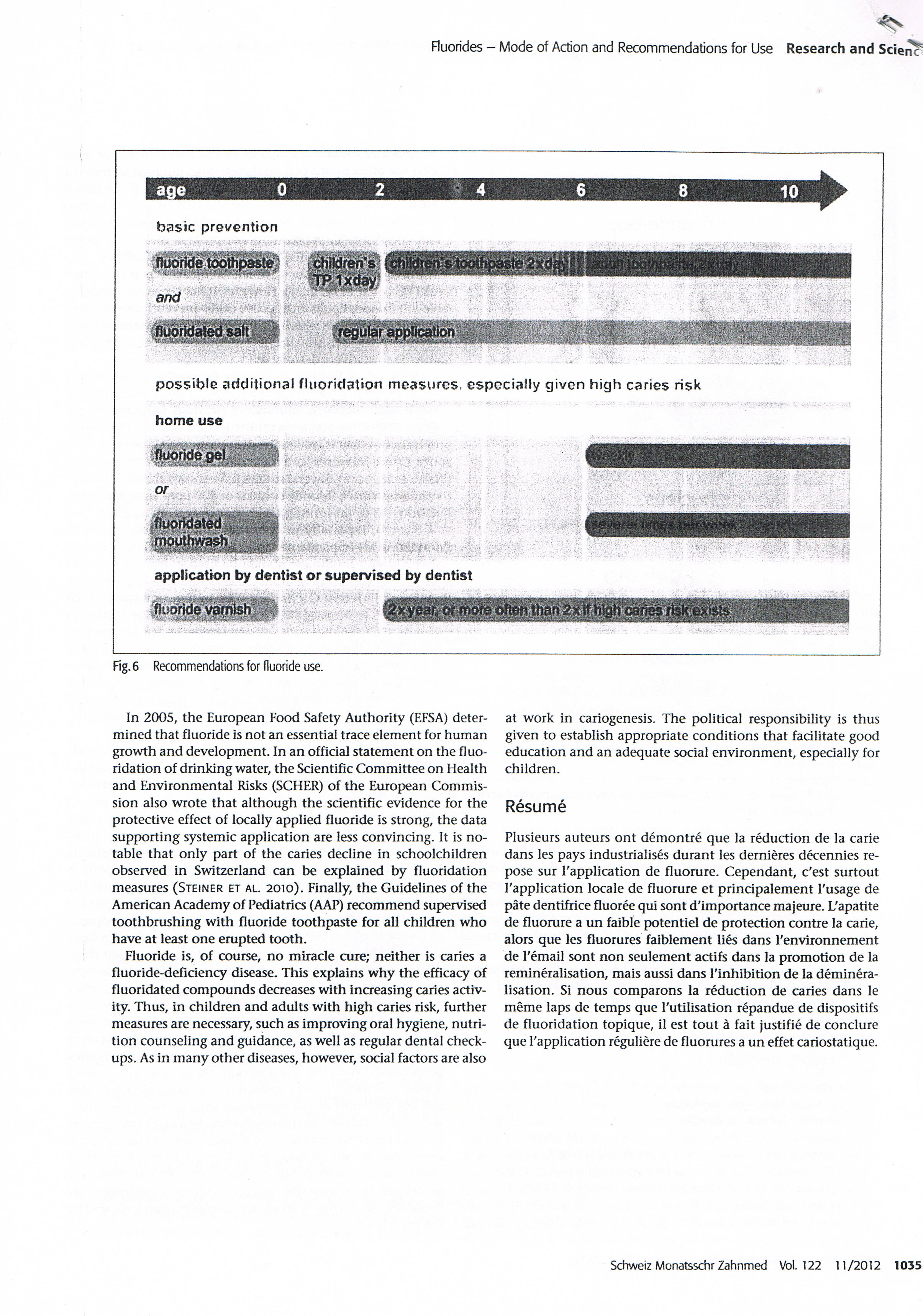CCF20130319�020

Fluorides - Modę of Action and Recommendations for Use Research and Scienc

!#«-
a .'.2..;::.T.":
|
fluoridated |
( | |
|
1 OUm |
■ |
application by dentist or supetvised by dentist
|
• . • | ||
Fig. 6 Recommendations for fiuoride use.
In 2005, the European Food Safety Authority (EFSA) deter-mined that fiuoride is not an essential tracę element for human growth and development. In an official statement on the fluo-ridation of drinking water, the Scientific Committee on Health and Fjwironmental Risks (SCHER) of the European Commis-sion also wrote that although the scientific evidence for the protective effect of locally applied fiuoride is strong, the data supporting systemie application are less convincing. lt is notable that only part of the caries decline in schoolchildren observed in Switzerland can be explained by fluoridation measures (Steiner et al. 2010). Finally, the Guidelines of the American Academy of Pediatrics (AAP) recommend supenised toothbrushing with fiuoride toothpaste for all children who have at least one erupted tooth.
Fiuoride is, of course, no miracle cure; neither is caries a fluoride-deficiency disease. This explains why the efficacy of fluoridated compounds decreases with inereasing caries activ-ity. Thus, in children and adults with high caries risk, further measures are necessary, such as improving orał hygiene, nutri-tion counseling and guidance, as well as regular den tal check-ups. As in many other diseases, however, social factors are also at work in cariogenesis. The political responsibility is thus given to establish appropriate conditions that facilitate good education and an adequate social environment, especially for children.
Resume
Plusieurs auteurs ont demontre que la reduction de la carie dans les pays industrialises durant les dernieres decennies re-pose sur 1'application de fluorure. Cependant, c'est surtout 1'application locale de fluorure et principalement 1'usage de pate dentifrice fluoree qui sont d'importance majeure. L'apatite de fluorure a un faible potentiel de protection contrę la carie, alors que les fluorures faiblement lies dans l’environnement de 1'email sont non seulement actifs dans la promotion de la remineralisation, mais aussi dans 1’inhibition de la deminera-lisation. Si nous comparons la reduction de caries dans le meme laps de temps que 1'utilisation repandue de dispositifs de fluoridation topique, il est tout a fait justifie de conclure que 1'application reguliere de fluorures a un effet cariostatique.
11/2012 1035
Schweiz Monatsschr Zahnmed Vol. 122
Wyszukiwarka
Podobne podstrony:
CCF20130319�016 Fluorides - Modę of Action and Recommendations for Use Research ano. source &n
CCF20130319�018 Fluorides - Modę of Action and Recommendations for Use Research and S Fig. 3 Solubil
ones) and for the information system attached to the Ministery of Education and Science. One can say
8. Herman A, Herman AP. Caffeine’s mechanisms of action and its cosmetic use.
00013 ?5c5a58795d3d3cd940c33cedaf2990 12 Woodall & Faltin We maintain, moreover, that before a
Collegium CivitasCollegiumCivitas Collegium Civitas address: Pałace of Culture and Science, 12th
File0046 3 Choose the best answers. 1 The construction of the Pałace of Culture and Science took&nbs
Collegium Civitas Admissions Office address: Pałace of Culture and Science, 12th floor Plac Defilad
MA in International Business and NegotiationsCollegium Civitas address: Pałace of Culture and Scienc
Collegium CivitasMA in International RelationsCollegium Civitasaddress: Pałace of Culture and Scienc
MA in Management and Global AffairsCollegium Civitasaddress: Pałace of Culture and Science, 12th flo
Collegium CivitasBA in International BusinessCollegium Civitas address: Pałace of Culture and Scienc
BA in European StudiesCollegium Civitasaddress: Pałace of Culture and Science, 12th floor Plac Defil
Collegium CivitasBA in International RelationsCollegium Civitas address: Pałace of Culture and Scien
MA in Diplomacy and Intercultural StudiesCollegium Civitasaddress: Pałace of Culture and Science, 12
YKPAIHA MIHICTEPCTBO OCBITM I HAYKM YKPAIHMUKRAINĘ MINISTRY OF EDUCATION AND SCIENCE OF UKRAINĘ3anpo
więcej podobnych podstron